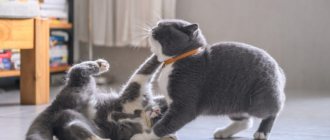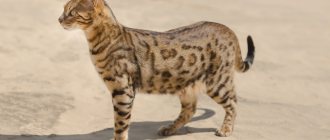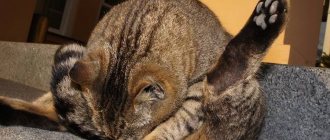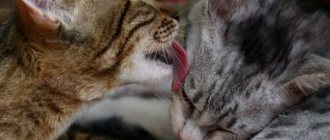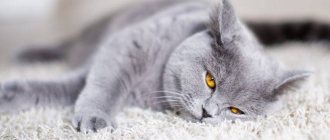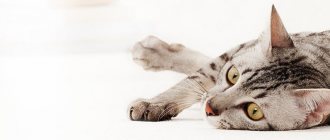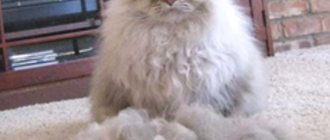Can all dogs be friends with cats?
In the wild, cats and dogs are natural enemies. Because of this, the former instinctively bypass the latter immediately after detecting the pungent odor of a dog.
For dogs, the situation is different. When they see a cat, most of them activate their pursuit instinct. Without control from the owner, the dog can not only injure the unfortunate animal, but also kill it.
These facts are truly frightening, but we still must not forget that both cats and dogs are social animals that need communication. With regular joint feeding, they can easily get along in the same territory, ignoring each other, but under the correct and sensitive guidance of a patient owner, their relationship can also easily develop into friendship. This is easiest for companion dogs who are devoid of aggression and intolerance.
What does the owner need to do to ensure peace reigns in the family?
The easiest option is to adopt a puppy and a kitten at the same time. In this case, the kids will grow up on equal terms and will find a common language with each other much faster through joint games.
If there is already a cat in the house, get a puppy. In this situation, the four-legged “recruit” is more likely to suffer, so, in addition to the dog’s character, it is important to take into account the friendliness of the “mustache.” To build strong relationships between animals you will need:
- Get acquainted correctly. On the first day, it is better to lock the puppy in a separate room so as not to provoke the furry “old-timer” into a conflict. The next day they can see each other and sniff.
- Provide each pet with a separate rest area. Bowls and toys should also be personal. If the animals themselves want, they will share them on their own initiative.
- Distribute your love evenly. Focusing on one person can lead to jealousy and competition for your attention.
It’s hardest with older dogs, but in this case, friendship is also real. To do this, the four-legged dog must be raised and socialized, stopping at the slightest manifestation of aggression towards a furry family member and cats encountered while walking on the street.
By the way: many smart dogs do not harm children. Therefore, in this case, it is worth checking the reaction to the kitten: most likely, the dog will accept the baby and even take him “under his wing.”
“
Read more about how to make friends between a cat and a dog
What to look for when choosing a puppy
Before purchasing a puppy, the future owner needs to clearly decide on the desired breed and the purpose of getting a dog. It is advisable to study the characteristics of the breeds so as not to get into trouble. The fact is that, through the long efforts of scientists, some breeds initially have a dominant function, aggression, for example, towards animals, wariness and distrust towards humans. Other dog breeds, on the contrary, are distinguished by their soft and cheerful character, and the ability to get along with both people and animals. Therefore, the owner, first of all, needs to focus on his own needs and the character of the future dog, and not on the appearance of the animal. So, before buying a dog you need to:
- Decide not only on the breed, but also on the size of the pet.
A small living space is unlikely to allow keeping large breed dogs (mastiffs, Great Danes, etc.). In addition, many four-legged animals need physical activity, which is usually only possible when living in private or country houses with fenced areas. - Understand whether it is possible to care for a dog that sheds heavily or has long hair.
If the dog owner has little time, then having a pet that requires daily care is quite unreasonable - both the pet and the entire apartment, covered with a layer of fur, will look untidy. - Decide on the age of the animal
- usually puppies are purchased at the age of 2 months. In this case, you can shape the dog’s character according to your own desire, while adult dogs, firstly, will have a more difficult time adapting to a new home, and secondly, will have habits instilled by a stranger (the breeder). - Select the gender of the dog.
Typically, females are more good-natured and calmer than males. While males are more active, without proper education they can provoke fights with other animals - both at home and on a walk. - Find out where exactly you plan to buy a puppy
- at a poultry market, via the Internet, in a breeding nursery. The prices of dogs from the kennel seem high, but this is where you can buy a healthy and vaccinated animal with documents, born from dogs without genetic diseases. - Before buying a puppy, you should make sure of its health
- look at the condition of the teeth, eyes, ears, feel the belly, paws, examine the fur, and also be sure to ask the seller (especially when the animal is purchased at the market) about the dog’s parents, its character, and nutrition.
Whatever breed of puppy is chosen, the owner must always be clearly aware of his responsibility, which consists of: good care (walking, bathing, combing, hygiene procedures), high-quality nutrition (natural food or ready-made industrial food), daily communication with the dog (including games, education and training), in regular preventive examinations at the veterinarian, in organizing the dog’s place (a home bed in a quiet and calm corner, an outdoor enclosure with an insulated booth), in one’s own capabilities - a dog always requires a lot of time, she can be naughty and even act contrary to the owner, be disobedient at first. However, the owner’s reaction can be moderately strict; under no circumstances should you hit the dog or yell at it.
What breeds of dogs get along well with cats?
In addition to companion dogs, many decorative breeds are classified as friendly four-legged dogs. Due to their modest size, they rarely terrorize cats and cannot cause them accidental harm with their weight during games.
Maltese (Maltese)
Small dogs that get along well with cats include Maltese dogs. These sociable and loving fluffies are devoid of aggression and easily make contact with other animals and strangers. This makes the Maltese very easy to steal.
INTERESTING!
In 2007, a Maltese named Trouble received an inheritance of $12 million from her owner, American businesswoman Leona Helmsley.
The main disadvantage of the Maltese dog is jealousy. It can encourage the dog to commit vile meanness, so be sure to ration your attention and do not play favorites in the family.
Pug
Funny and sociable, Pugs are not aggressive or jealous. They become attached to all family members and enjoy playing with other pets.
The only point worth paying attention to when keeping a pug and a cat together is the vulnerability of the former’s eyes. They are very easy to damage with claws, so as the plate grows, the “mustache” will have to undergo a forced manicure.
Pugs cannot stand being alone, so having a furry friend will be a big plus for them. Despite this fact, they do not suffer from obsession. It is not typical for pugs to follow their owner 24/7, begging for affection.
Labrador Retriever
The Labrador Retriever is completely devoid of aggression and is devoted to man to the depths of his soul. He gets along easily with other animals and never offends them.
Initially, Labradors were bred to find and fetch game, but eventually most owners began to use them as regular companions. Thanks to their developed intelligence and calm nature, they quickly remember commands and obey their owners unquestioningly.
Golden retriever
Like the Labrador, the Golden Retriever was bred for gun hunting. The character of these animals is largely similar, but there are some differences. Labradors are more energetic and active. Because of this, they can bother cats with their intrusiveness and excessive playfulness. This problem does not arise with golden retrievers, since, in addition to friendliness, their main qualities are calmness and self-control.
Thanks to their patience, representatives of this breed treat children very correctly. They forgive them any pranks and carefully protect them from dangers.
Beagle
The Beagle is a hound with a phenomenal sense of smell and a clear voice. He was bred to herd deer and hares, which is a very controversial fact for conflict-free cohabitation with “mustaches.” Despite this, most owners assure that in such a tandem the cat is usually the main instigator. If your pet has a peaceful character, then with the right introduction, a beagle can become his friend.
INTERESTING!
The US Department of Agriculture maintains a special beagle team that checks airport passengers for the presence of prohibited foods.
The main advantage of the beagle is its good nature. He loves the attention of others and understands the meaning of the word “family.” However, a beagle is quite capable of attacking a neighbor's cat, who has nothing to do with him.
Newfoundland
The powerful giant becomes firmly attached not only to the “mustaches,” but also to all other pets. He even builds warm relationships with parrots and hamsters, so you don’t have to worry about the safety of your cat next to your Newfoundland.
Representatives of this breed are used to rescue people on water. Trained dogs are capable of not only pulling a drowning person ashore, but also successfully towing a load weighing up to 700 kg.
“One of the characteristics of Newfoundlands is analytical thinking. Thanks to him, they rush to help someone in need without hesitation, without waiting for the appropriate command to be received.
Papillon (Continental Toy Spaniel)
Representatives of this breed show a special love for cats, since most of them are close to them in size. Thanks to their innate optimism and playfulness, Papillons very quickly find friends, involving them in their pranks and adventures.
Aggression on the part of friendly four-legged animals is the result of a lack of socialization and education. Other reasons for deviation of standard behavior include rudeness and psychological pressure.
Basset Hound
Basset Hounds are only patient with animals that are part of their family. They can drive and pursue everyone else out of instinct, but it is better to stop such behavior immediately.
These funny and clumsy hounds with an extremely low slouch only show their hunting skills when working. At home, they prefer to lie on the sofa and fill their bellies with a variety of goodies. Because of the latter, basset hounds very often gain excess weight, so their feeding regime and immediate diet must be strictly controlled.
Cavalier King Charles Spaniel
Dogs that love cats also include the Cavalier King Charles Spaniel. This shaggy fidget is on a wave of positivity 24/7 and is extremely dependent on the person. If there is a lack of attention, he can cause mischief and make a mess, so having a cat in the house is a reliable way to stop senseless destruction.
Leadership and the desire to dominate are alien to the Cavalier King Charles Spaniel. For this reason, he never offends other animals, but, on the contrary, tries to be friends with them. The Cavalier King Charles Spaniel has a special love for tactile contact, so attempts at a “milk step” on the part of the cat bring him real delight.
Bichon Frize
This miniature companion dog is the perfect family pet. The Bichon Frize is easy-going and always full of energy. He is in dire need of communication and easily makes new acquaintances, involving everyone in his funny games.
INTERESTING!
Numerous images of the Bichon Frize are found in the paintings of the Spanish artist Francisco de Goya.
Despite being sociable and friendly, the Bichon Frize loves to bark. If the cat is indifferent to this feature, then they will definitely be able to make friends.
Poodle
Elegant and pretty, poodles have high intelligence and a kind nature. Among the smartest four-legged animals, they occupy an honorable 2nd place, so they are easy to train even with a lack of experience.
Due to their non-aggressive nature, poodles are not suitable for guard duty, but they can become excellent friends for cats and playmates for children. Despite their exquisite appearance, representatives of this breed were bred for hunting. Due to their innate mobility and energy, they need not only regular, but also active walks.
Boston Terrier
Boston Terriers are a good choice for beginners. They are friendly, welcoming, pliable and completely non-confrontational. Both children and pensioners can cope with their upbringing.
Due to the lack of aggression and suspicion, Boston Terriers are completely calm about doorbells and do not bother their neighbors with their loud barking. They quickly form strong friendly bonds with representatives of the cat family. An attack on the “mustache” is possible only in a playful manner, but even in this case the dog will be reaction-oriented. If the cat is categorically against it and hits the four-legged prankster with his paw, the latter will quickly calm down and stop bothering him.
Yorkshire Terrier
The courage and playfulness of these kids is surprisingly combined with their intelligence and delicacy. Unlike most terriers, Yorkies, bred to catch rodents, quickly became common companions. They are friendly to other animals and easily find a common language with them.
Intelligent and loyal, Yorkies are easy to train and do not display dominance. Despite their small size, they are full of courage and are ready to defend their family without hesitation.
Shih Tzu
The Shih Tzu is another miniature companion dog, famous for its friendliness and sociability. She shows her affection to absolutely all family members: adults, children, other four-legged animals and, naturally, cats.
Thanks to her strong nervous system, the Shih Tzu is patient with the pranks of kids, but only until they hurt her. For outright bullying and violence, the animal will give back without further warning.
Bernese Mountain Dog
Despite its impressive size, the Bernese Mountain Dog is an ideal companion with an unusually peaceful character. He learns quickly and willingly follows commands. There are no problems in establishing relationships with mustachioed pets. If they don’t mind, the dog quickly becomes their friend.
INTERESTING!
In the mid-19th century, Bernese Mountain Dogs were used as draft power to pull milk carts.
Bernese Mountain Dogs are calm and phlegmatic. Increased curiosity and carelessness on their part are possible only in puppyhood.
The history of the appearance of different breeds of dogs
If we turn to antiquity, we can identify the main ancestor of all today's dog breeds - the wolf. Scientists have different opinions about the time of domestication of the wolf; according to various sources, this happened from 15,000 to 50,000 years ago. The reasons for the predator's attachment to human groups are not clear. One version says that nomadic peoples used wolves for hunting and personal needs (the meat of tamed wolves was eaten, and clothes were made from the skins). Another version is that wild animals themselves sought food from ancient people. Allegedly weakened and expelled from the pack, individuals independently joined human settlements and were used for the same hunting and home protection. The remains of dogs have been found on all continents without exception, their images are immortalized on ancient bas-reliefs and paintings, which indicates the long-standing popularity of these animals.
Scene of a wild boar hunt with a dog, ancient Roman sculpture
The oldest breeds of dogs
were formed on Earth at a time when no one knew about selection. These are individuals (aboriginal or primitive) whose DNA is closest to wolves - Akita and Shiba Inu, Alaskan Malamutes, Siberian Huskies, Shar Pei and others. Over time, in addition to native dogs, factory dogs began to appear - bred as a result of crossing animals of various primitive breeds. The formation of most factory breeds was based on inbreeding - intrageneric crossing of aboriginal individuals, as well as the identification and elimination of its undesirable consequences (aggressive or timid character, abnormal body structure, unattractive exterior). Dog selection reached its heyday in the 19th – 20th centuries, when most dog breeds were bred and approved by cynological organizations.

